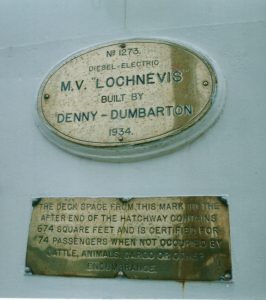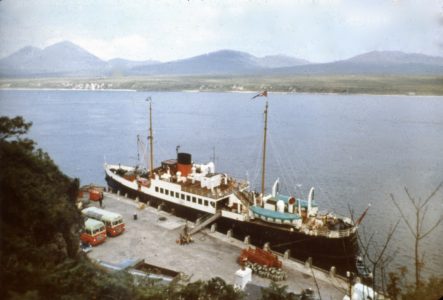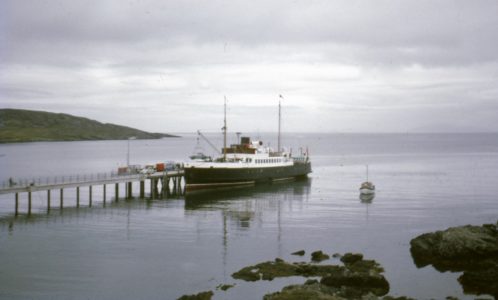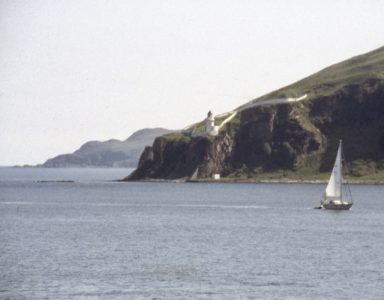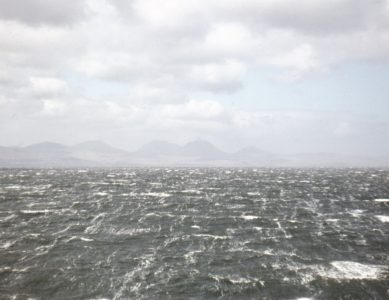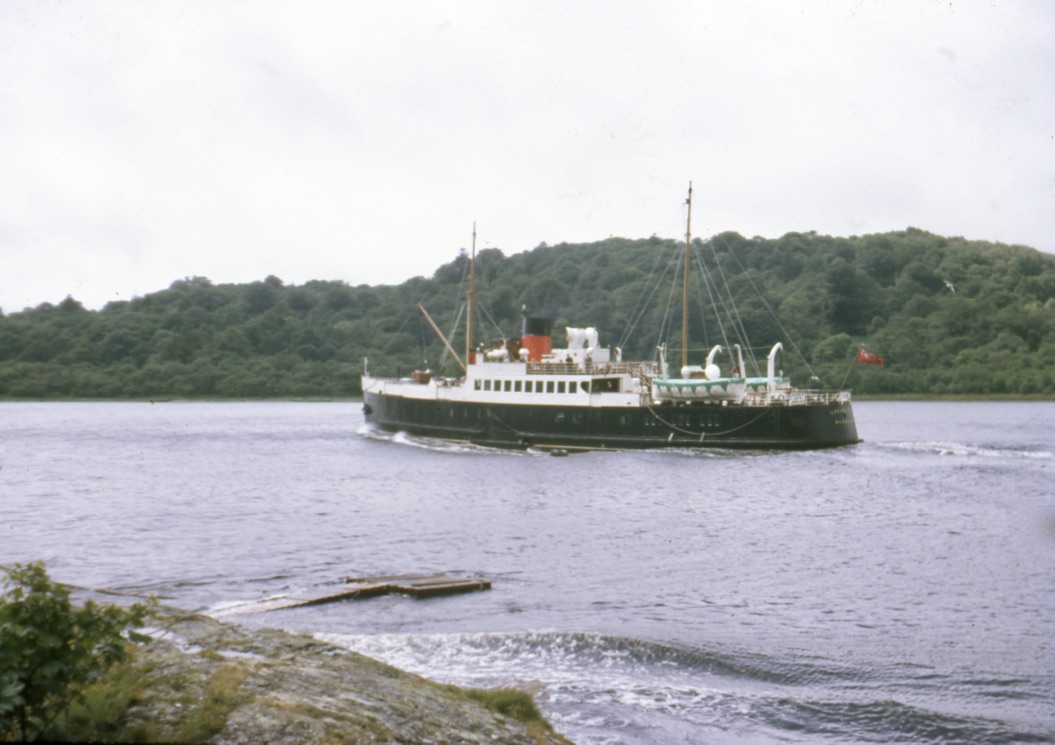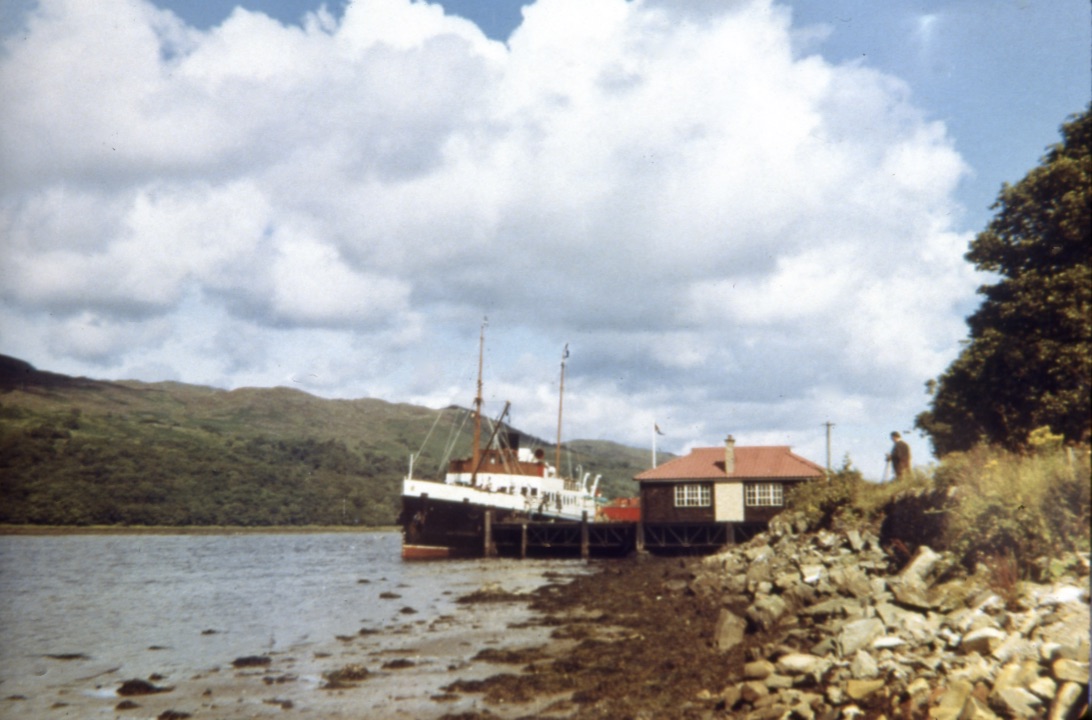
‘For many of us, the oldest recollections are the most vibrant’: Lochnevis at West Loch Tarbert pier on 28 August 1967. Copyright Lawrence Macduff
Continuing his ‘Confessions of a Cameraman’, Lawrence Macduff invites us to join him on the scenic voyage from West Loch Tarbert to Jura, Islay, Colonsay and Oban, which the MacBrayne mail ship Lochnevis undertook on summer Mondays in the late 1960s. Lawrence’s account is followed by his own photographs of some of the scenes he describes.
Many of the most dramatic voyages that can be made aboard a passenger and vehicle ferry in Britain are those connecting the west coast of Scotland to the Western Isles. I first made the passage I am eulogising here in 1967. It left the most indelible impression on the mind of this 21-year old lad, for that’s all I was then.
From my schoolboy readings at Dunoon library I had learned much about ships that served the west coast and the routes on which they were engaged. The seamen’s strike in midsummer 1966 delayed my first foray into Hebridean waters, but finally it happened on 17 September that year, when I joined Lochiel for her regular crossing from West Loch Tarbert to Port Ellen via Gigha. Having enjoyed stunning weather on that occasion, it was with the greatest anticipation that on Monday 3 July 1967 I sailed with that maid of all work, Lochnevis, on her passage from West Loch Tarbert to Oban via Jura, Islay and Colonsay.
During the course of the 1960s the volume of vehicles requiring transport to Islay in summer became such that a single ship could no longer cope. So, during peak season weekends from 1965 until 1969, Lochiel, the principal incumbent on the route, was re-deployed to provide additional sailings for vehicles and their passengers, while Lochnevis, the regular relief ship, took over the main service roster.
But every Monday this ship additionally worked right through to Oban where she was required for mid week excursion duties. That was how I first came to experience the delights offered by this incomparable positioning voyage.
Looking back over so many years it is safe to say that, for many of us, the oldest recollections are the most vibrant. As well as the striking visual impact of scenery viewed from this passage, there was for me the pleasure of travelling on a favourite old ship with her characteristic shipboard smells and sounds.
Such sensations added to the impressions I gained on this first foray to Oban. To reach this iconic gateway to the islands, right to this very day there is no better way than to arrive by sea from the south.
The sailing down West Loch Tarbert is one of the more convoluted of Hebridean passages, and several course changes are required to reach open sea beyond Corran Point at the foot of the loch. Older readers will recall how, owing to a course error, Lochiel came to grief in the loch in 1960. In the days of my youth, all Islay services departed from the old West Loch pier, now used only by fishing and leisure craft. Given its constricted position at the head of the loch, it offered limited width for turning the ship and minimal depth at low tide. Accordingly ships built for this route were designed with a shallow draft to access the West Loch pier but, out at sea in poor weather, Lochiel in particular could roll miraculously.
It seems to be a quirk of my oldest memories that the sun almost always shone in those days. Certainly, on the day of my 1967 mid summer passage, conditions were fine and settled right from the start. I had already enjoyed the traditional ‘Royal Route’ service on Lochfyne from Gourock to Tarbert’s east pier, a pleasure in its own right. The connecting West Coast Motors’ 29-seater transferred me and a few other passengers to the West Loch pier where I immediately boarded Lochnevis, familiar to me from her winter relief duties on the Clyde.
As always at West Loch Tarbert, there was activity aplenty. The constrained marshalling area at the pierhead invariably made for somewhat chaotic operations, and this day was no exception as Lochnevis discharged her inbound traffic and began to embark passengers and cargo. By 12.55 the work had all been completed. The Master was out on the open bridge wing intently checking final sailing preparations, the red wooden gangway was manhandled back onto the pier and, virtually on the stroke of 1pm, the bow ropes were cast off. The exhaust note from the ship’s funnel sharpened as the bow gradually eased away from the aged timber piles. I watched and listened, absorbing everything, and to this day, I am still fascinated by the sight of a ship arriving or leaving a port, and all that goes with that process.
The first couple of miles of the West Loch offer few hints of what lies beyond its narrow, twisty and well wooded upper reaches. After about 20 minutes you pass the site where the Kennacraig terminal was established by Western Ferries in 1967 (and adopted by CalMac in 1978): from here you begin to see what lies beyond. Pretty much dead ahead, though slightly to port, the domed profile of Dunskeig marks the spot where West Loch Tarbert starts to widen out to the open sea. On our left side, Kintyre’s pastures are still gentle and well grazed, while to starboard, the landscape remains thickly wooded, broken up only by the occasional small traditional dwelling close to the shoreline.

The foredeck on Lochnevis was accessible from the for’ard lounge: this view features Peter Reid, who often shared youthful Hebridean jaunts with Lawrence. Copyright Lawrence Macduff
Lochiel had a well deck separating the fo’c’sle from the accommodation, so the only view for’ard was from her spacious lounge. By contrast, Lochnevis had a foredeck accessible from the for’ard lounge, and there was nowhere better from which to savour these vistas. All the same, it was a working area. The cargo hatch was sited midships with the derrick overhead, and there were various obstructions – it was all too easy to be carried away by the scenery and collide with something you didn’t notice! From up for’ard, if the ship changed course to any extent, you could see her perceptibly lean to one side as she responded to the helm. All was peaceful because the fo’c’s’le was distant from the busy clamour of ship’s machinery as she proceeded at her steady 13½ knots: a glance over the teak railing showed that she went along at a fair clip for a 33-year old ship. Lochnevis really benefited from her 1957 re-engining, which increased her power by some 10 per cent.
To starboard you could see the first tantalising glimpses of the Paps of Jura, while on the port side we were now approaching the ruined hill fort of Dunskeig, 423-foot high. It was not until 1980 that I first climbed up to this fort and was figuratively blown away by the panorama – though I did lose a woolly tammy on one Easter visit. The distinct humped profile of the small satellite isle of Cara lay some way to the south, with neighbouring Gigha beside it, while the long sand spit near to Tayinloan in Kintyre could just be detected, sweeping out from the shoreline. As we neared Ardpatrick Point to starboard, the glorious sight of the Paps of Jura came into full view thanks to the receding promontory near Kilberry in Knapdale. Our course now eased more nor’westerly as we headed across open waters towards Lowlandman Bay on Jura for our scheduled call at Craighouse, the island’s main settlement. Some 30 miles distant, the steeply sloping headland of the Mull of Kintyre could still be seen.
As Jura’s mountains gradually grew larger, looking greater than their 2,500 feet would suggest, we could see the light on Skervuile rock lying some way off to the north in the middle of the Sound — a necessary landmark for any shipping in the vicinity.
The substantial stone pier at Craighouse lies in sheltered though relatively shallow waters. We were there just long enough to drop a little cargo and a handful of passengers before continuing round the south end of Jura and into the Sound of Islay. I have always enjoyed the way you can island hop with your eyes as you sail northwards up the west coast. On the crossing from Ardrossan to Arran you can see Jura; from Jura you can see Mull; from Mull you can see Skye, and from Skye you can see South Uist and Harris. Despite lying many miles from each other, these islands are all sufficiently high to be visible at considerable distances.
Just as every ferry enthusiast has a favourite ship present or past, most of us also have a favourite port. Mine is Port Askaig, one of the bonniest in the Western Isles. On this occasion Lochnevis glided gently past the striking wood-shrouded Dunlossit House towards the pier, her Master making a cautious approach to account for the tidal current in the Sound of Islay, which can run at up to seven knots. We now had a grandstand view of this neat little hamlet, with its lifeboat station, hotel, traditional timbered pier with MacBrayne’s trademark buildings — and a MacBrayne mail bus waiting on the pier, bound for Bridgend, Portnahaven and Port Ellen. Looking across the Sound, with the Paps taking on their most conical profile, it was hard to imagine a finer view from any of MacBrayne’s ports of call.
The next stage of our passage took a little over an hour as we headed north towards open sea. Shortly after our departure from Port Askaig, the neat Caol Ila distillery revealed itself in a small bay to port, followed by the more substantial Bunnahabhain distillery a couple of miles further north. Mull remained dead ahead, with the tall graceful tower that is Rhuvaal lighthouse now in sight to port, marking our exit from the Sound of Islay.
As we headed out to sea, a low lying ribbon of island became discernible. Approaching Colonsay, our Master guided Lochnevis towards a modern concrete pier which, at that time, was only two years old. Until 1965 Colonsay, like many Hebridean islands, could only be accessed by using one of MacBrayne’s small fleet of timber-built motor launches dating from the early 1950s, which came out to meet the mail ship.
With a population of only 90, Colonsay did not detain us for long. The final two and a half hour passage to Oban lay ahead of us, with stunning views all round — Jura (its peaks still prominent) and Islay astern of us, the indented Argyll coast to starboard and the increasingly rugged and mountainous aspect of Mull ahead.
On this first passage in these waters, I found it difficult to figure out all that I was seeing. Forty years later, after many successive voyages, I recognise much more — yet the appeal of this route never lessens.
To the east lay Scarba, a striking looking island when seen from Crinan or Luing — though in our view of it from out at sea, it rather blended in to the Argyll background. It is, in fact, no less than 1,500 feet high and separated from the north of Jura by the famous Sound of Corryvreckan. Weather permitting, Lochnevis was scheduled later in this first week of July 1967 to undertake the Six Lochs Cruise, taking her through the fascinating whirlpool.
Continuing northwards, we passed quite close to the randomly scattered Garvellachs. Sadly for me, the excellent binoculars I would receive for my 21st birthday were still six months’ distant.

Lochnevis berthed outside Claymore at Oban’s Railway Pier on 17 July 1969. Copyright Lawrence Macduff
I think I can safely say there are few occasions on the Colonsay-Oban passage when there is not something to occupy your attention. If you do find a temporary period with little of note, you can always hightail it to the ship’s cafeteria — though on Lochnevis this was not the quietest or most inspiring of places.
All good things come to an end — but not before the grand finale of our passage. Entering the Sound of Kerrera, Lochnevis would usually maintain her speed as she passed the ruins of Gylen Castle to port (nowadays cared for by Historic Scotland). As we approached Kerrera Ferry, the small launch which at that time provided the most basic of links lay at her rudimentary stone berth on the island. The ship’s helmsman had to undertake several further changes of course as we continued towards the expanding vista of Oban, and berthed at the Railway Pier where Lochnevis made fast for the night.
On my first voyage on this route Lochnevis suffered an engine failure before reaching Port Askaig. Sailing on one engine at 10 knots, she reached Oban two hours late, at 10.30pm. No mobile phones in those days, so I had no way of letting my landlady know about the delay, but as a former stewardess on the 1955 Claymore Mary Lamont probably saw from her elevated sitting room window that Lochnevis had not arrived on schedule. She may also have found out what had happened through radio telephone contact with her husband Willie, Claymore’s bosun. Whatever, even by the time I arrived, Mary had not yet locked up for the night, and I returned to her house year after year until she retired. I am still in touch with her and visit whenever I can.
If ever a voyage was to be a fitting introduction to the ‘kingdom of MacBrayne’, this was it. Half a century later these recollections still radiate warmth, much pleasure and a deep appreciation that I had the good fortune, at an impressionable age, to forge an interest that has lasted all my days.
SOME SCENES CAPTURED BY LAWRENCE ON HIS VARIOUS VOYAGES FROM WEST LOCH TARBERT TO COLONSAY AND OBAN:













